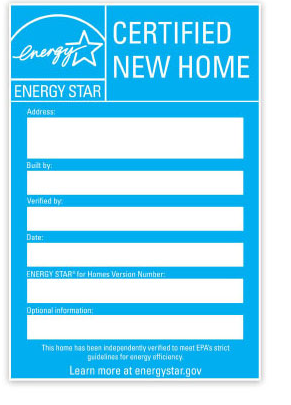Independent Inspections & Tests
 The blue label found on every ENERGY STAR certified home or apartment may look small, but what it stands for is really big.
The blue label found on every ENERGY STAR certified home or apartment may look small, but what it stands for is really big.
To earn the ENERGY STAR, a home or apartment undergoes a series of rigorous inspections and tests, performed by a third-party Energy Rating Company (or produced in a certified manufactured housing plant), to ensure that it meets the strict energy efficiency requirements set by the U.S. Environmental Protection Agency (EPA).
In turn, the work of these rating companies (and certified plants) is overseen by a Home Certification Organization (HCO), Multifamily Review Organization (MRO), or Quality Assurance Provider (QAP), independent organizations recognized by EPA to implement an ENERGY STAR certification program. These organizations are responsible for exercising final authority over decisions related to ENERGY STAR certifications for homes and apartments, including the credentialing, oversight, and quality assurance of the raters that verify homes and apartments to earn ENERGY STAR certification. Only homes that are certified through an EPA-recognized HCO, MRO, or QAP meet ENERGY STAR program requirements.
Learn more about independent inspections and testing in this fact sheet (PDF, 1.91MB).
How New Homes and Apartments Earn the ENERGY STAR
A home that meets EPA's strict energy efficiency requirements achieves this level of performance through a complete package of building science-based energy efficiency systems and measures that are third–party verified by a Home Energy Rater. Many steps are taken by the builder and Rater during design and construction to ensure all ENERGY STAR requirements are met and verified.
STEP 1: Builder or Developer Becomes an ENERGY STAR Partner
Through a partnership with ENERGY STAR, a builder or multifamily developer commits to constructing and verifying homes/apartments to meet all of ENERGY STAR’s strict energy efficiency requirements. The builder or developer also selects an Energy Rating Company to work with to certify their homes or apartments.
To find participating builder and developer partners in your area, visit the ENERGY STAR Partner Locator.
STEP 2: Builder or Developer Selects Energy Efficiency Features
The builder/developers submits their architectural plans to their Energy Rating Company (ERC) for review and analysis. The ERC and/or energy modeler looks for key information on the plans to help the builder choose the best combination of energy-efficient features to ensure that the home will earn the ENERGY STAR label when constructed. For most single-family homes and apartment buildings, the design team and ERC will select a custom energy efficiency approach using specialized energy modeling software. For manufactured homes and some multifamily buildings, the design team will rely on a prescriptive package of energy efficiency features developed by EPA. For a home to be truly energy efficient, its design and construction must consider local conditions. Energy Rating Companies’ verification staff are trained in climate-specific energy savings techniques, and their knowledge and field experience helps ENERGY STAR builder and developer partners select the most energy-efficient features.
STEP 3: Builder/Developer Constructs Home and Rater Performs Field Verification and Quality Control
With the energy-efficient features selected, the builder/developer proceeds with home construction. The Energy Rating Company conducts onsite inspections and testing* during and after construction to ensure rigorous ENERGY STAR requirements are met. Homes that earn the ENERGY STAR typically undergo significantly more systems engineering, inspections, and testing than home built to code. This extensive and detailed verification process identifies and corrects mistakes that may impact a home’s energy efficiency before they become problems and holds builders accountable to higher standards. The process typically includes a blower door test to measure whole-house air leakage and a duct blaster test to measure air duct leakage. During the inspection process, the Energy Rating Company utilizes a set of comprehensive ENERGY STAR checklists designed to deliver better efficiency, comfort, quality, and durability.
STEP 4: Rater Certifies the Home and Issues an ENERGY STAR Label
After the Energy Rating Company (ERC) completes the final site inspection and determines that all ENERGY STAR requirements have been met, the building undergoes additional quality assurance by a Home Certification Organization. The ERC then provides the builder/developer with the ENERGY STAR label, which is typically placed on the circuit breaker box of a home or apartment. This label is proof that the home is ENERGY STAR certified, and includes the home address, builder/developer name, ERC name, and date verified. The blue ENERGY STAR label makes it simple for homebuyers and renters to choose truly comfortable and energy efficient new homes and apartments.
*Builders and developers who have demonstrated an ability to consistently meet ENERGY STAR requirements may have homes that meet certain eligibility criteria certified based on tests and inspections performed on a sample of the homes.
